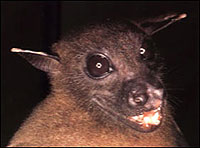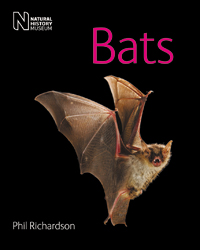The secret life of bats
By Phil Richardson

Solomons bare-backed fruit bat, Dobsonia inermis (Image: Phil Richardson)
Introduction
Of the world's 5,000 or so species of mammals, more than 1,100 - 1 in 5 - are bats. They vary in size from minuscule, almost butterfly-sized creatures, to huge animals with wingspans of nearly 2 metres. Thanks to their mastery of powered flight, bats are distributed across much of the world. They feed mainly on insects and fruits, but some eat nectar, frogs, fish, other small mammals or even blood.
Everyone reacts to bats, sometimes with horror but more often with fascination. Although they are linked in many people's minds with scary films, the truth about these amazing creatures' lives is very different. Bats have a complex lifestyle, a rich social life and senses that are almost beyond our comprehension.

Bats by Phil Richardson, 2011. Wherever you live, there are likely to be bats near you, so discover more with this highly readable and beautifully illustrated book.
Amazing, fascinating and bizarre are words that barely start to describe the bats of the world. There are such a large array of species. Some are big and some are tiny. Many eat insects and fruit, yet there are others with more unusual tastes in food, such as the fisherman bat which uses its claws to catch fish or the unjustly demonised blood-eating vampire bats. Bats will not fly into your hair and they are not blind, though most find their food and avoid obstacles in the darkness of night not by vision but by using their remarkable and highly developed sense of echolocation. Their role in pollination is crucial to the environment in which they live. Bats are full of surprises.
Bat expert Phil Richardson takes you on a guided tour of the nocturnal world of bats: where they live, how they feed, and how they survive in almost every habitat on the planet. He uses his experience of bat watching around the world to bring these misunderstood creatures to life, describing their complex life cycles, explaining how you can watch and study bats and help conserve these often threatened mammals.
Topics
- Bat evolution, diversity and classification
- Bat structure
- Bat senses
- Roosting and hibernating
- Breeding and feeding
- Bat conservation
About the author
Phil Richardson, once a science teacher but now a bat ecologist, spends days, nights and holidays working with bats. He helped popularise bats in the UK by making them appealing to the public in TV and radio presentations, and in the setting up of a number of volunteer bat groups and the Bat Conservation Trust, the UK national body involved in bat conservation.
Toolbox

In World War II the Museum was used as a secret base to develop new gadgets for allied spies, including an exploding rat!